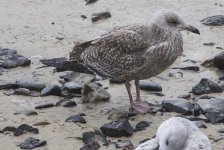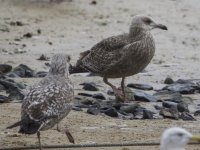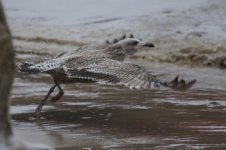-
Welcome to BirdForum, the internet's largest birding community with thousands of members from all over the world. The forums are dedicated to wild birds, birding, binoculars and equipment and all that goes with it.
Please register for an account to take part in the discussions in the forum, post your pictures in the gallery and more.
You are using an out of date browser. It may not display this or other websites correctly.
You should upgrade or use an alternative browser.
You should upgrade or use an alternative browser.
Gull help needed (1 Viewer)
- Thread starter Paul Penzance
- Start date
More options
Who Replied?Paul Penzance
Well-known member
Cornwall today
lou salomon
the birdonist
quite a clearcut 1st cycle HG, bills often misshaped or deformed in first cicle, later on their shape usually adjusts to normal proportions.
Paul Penzance
Well-known member
Thanks for the comments. I wasn't thinking on the Caspian lines but hoping it might have some Yankee genes!
lou salomon
the birdonist
got it. no, looks like a dark european one, a slight smith-look-alike. tertials, although worn, have broad pale tips, breast still a bit streaky, tail sides with much white and uppertail coverts not really barred, more black speckled on white ground, window quite strong with accentuated dark subterminal blobs.
btw., it can't have just 'some' Yank genes - either is it a Yank or it is a European since they don't mix .
.
btw., it can't have just 'some' Yank genes - either is it a Yank or it is a European since they don't mix
Do we know this for sure? —genuine questionsince they don't mix.
[would be unlike pretty much every other large gull..?]
lou salomon
the birdonist
where should that be? ranges are far apart from each other.
Core ranges, yes, but what would stop a vagrant smithsonianus from breeding with a European Herring Gull? On a population level, yes, you are correct that the two species don't 'mix' as in there is no overlap zone where both breed, but gene flow is still possible, of course, at least occasionally.where should that be? ranges are far apart from each other.
Vagrant US gulls are common enough (1+ pa) for the populations to be indistinguishable a genetic point of viewCore ranges, yes, but what would stop a vagrant smithsonianus from breeding with a European Herring Gull? On a population level, yes, you are correct that the two species don't 'mix' as in there is no overlap zone where both breed, but gene flow is still possible, of course, at least occasionally.
lou salomon
the birdonist
yes, but apart from Ring-billed Gull, no hybridization events with european taxa have been documented, this side of the pond, and none on the other side.
dantheman
Bah humbug
That'll be partly because the offspring would be almost impossible* to recognise and coming across actual breeding a very rare event statistically?! Presumably an adult American Herring Gull over here would still want to breed ...yes, but apart from Ring-billed Gull, no hybridization events with european taxa have been documented, this side of the pond, and none on the other side.
Just had a quick look; check out 'Appledore Gull' in N America - LBBG and AHG. LBBG formerly a vagrant species.
*(plenty of 'odd' birds about mind)
lou salomon
the birdonist
Appl
That'll be partly because the offspring would be almost impossible* to recognise and coming across actual breeding a very rare event statistically?! Presumably an adult American Herring Gull over here would still want to breed ...
Just had a quick look; check out 'Appledore Gull' in N America - LBBG and AHG. LBBG formerly a vagrant species.
*(plenty of 'odd' birds about mi
Appledore Gull is a hybrid between 2 genuine American breeders (while Greenland is sth. 'in between', still undetected small colonies of LBBG have to be somewhere on Labrador and LBBG is wintering in large numbers in NA.). And yes, a putative smith x arg would be extremely hard to recognize on either side of the pond. But it's very unlikely, especially in the context of a large number of smith-lookalike argentatus in Iceland and Norway.That'll be partly because the offspring would be almost impossible* to recognise and coming across actual breeding a very rare event statistically?! Presumably an adult American Herring Gull over here would still want to breed ...
Just had a quick look; check out 'Appledore Gull' in N America - LBBG and AHG. LBBG formerly a vagrant species.
*(plenty of 'odd' birds about mind)
Sorry I find this hard to follow. The previous sentence said "very hard to detect" and here we say there's a population in between which is arg- but looks like smith-. This sort of sounds like evidence of intergradation to me but at the v least surely reinforces the point that hybridisation is a) possible, and b) would likely be extremely difficult to detect from phenotypes.But it's very unlikely, especially in the context of a large number of smith-lookalike argentatus in Iceland and Norway.
I think gulls are really interesting from an evolution-in-action point of view, but don't ask me to draw species limits between the big ones while there's no good modern/recent molecular work (that I'm aware of).
Yes we can see different more or less well marked phenotypes but then we can for redpolls too...
lou salomon
the birdonist
sorry for the misunderstanding. the 'in between part' was describing Greenland (as host of substantial LBBG colonies) geaografically, between NA and Europe. So Appledore Gulls (LBBG x American Herring Gulls hybrids) are much more likely and relative commonly observed, just because some of the many wintering LBBG seem to decide to stay with a smithsonianus as partner. Not so with argentatus and smithsonianus which only occasionally get to each others opposite side of the pond. If such a bird breeds with a non-conspecific partner on the "wrong" side, this wouldn't cause any gene flow into the populations.Sorry I find this hard to follow. The previous sentence said "very hard to detect" and here we say there's a population in between which is arg- but looks like smith-. This sort of sounds like evidence of intergradation to me but at the v least surely reinforces the point that hybridisation is a) possible, and b) would likely be extremely difficult to detect from phenotypes.
I think gulls are really interesting from an evolution-in-action point of view, but don't ask me to draw species limits between the big ones while there's no good modern/recent molecular work (that I'm aware of).
Yes we can see different more or less well marked phenotypes but then we can for redpolls too...
dantheman
Bah humbug
I was thinking of it as an example where in the recent past (last couple of centuries?) it wasn't an American breeder - presumably the earliest ones in N America would still also have hybridised with AHG. (As an aside - how recent is the Greenland population of LBBG?) as an example of a vagrant hybridising.Appledore Gull is a hybrid between 2 genuine American breeders (while Greenland is sth. 'in between', still undetected small colonies of LBBG have to be somewhere on Labrador and LBBG is wintering in large numbers in NA.). And yes, a putative smith x arg would be extremely hard to recognize on either side of the pond. But it's very unlikely, especially in the context of a large number of smith-lookalike argentatus in Iceland and Norway.
With maybe 10s or 100s of individual American gulls of various species occurring in the Western Palearctic in any decade, there has to be scope for hybridisation - on the basis that gulls will breed! (cf eg terns - easier to find mixed breeding pairs at colonies eg Cabot's Tern (subspecies?) in Wales and Lesser Crested Tern in England etc). Hybrids will occur, at what density who knows - null hypothesis that they don't occur hard/impossible to disprove.
Some birds have been proven (I believe) to travel back to their continent of origin, however events where multiple individuals occur has happened eg in other species/groups (waterfowl, RB Gulls etc) and have bred, producing valid hybrid young. Conjecture for AHG perhaps, but still ...
(This discussion isn't meant to indicate that the gull in the OP is indeed a hybrid btw ;-) )
Puzzled. If a bird from one population/species breeds successfully - even only once - with, and within the range of, birds of another population/species then that is gene-flow between those populations, even if only in one direction and minute.Not so with argentatus and smithsonianus which only occasionally get to each others opposite side of the pond. If such a bird breeds with a non-conspecific partner on the "wrong" side, this wouldn't cause any gene flow into the populations.
lou salomon
the birdonist
All this hypothesis of a possible interbreeding doesn't interfer with the fact that dark looking argentatus can look deceptively like smithsonianus and not because they have smith genes but because of intraspecific variation. You can't explain the large number of dark looking 1st cycle argentatus (with more or less similarity to smithsonianus) by a few potential smiths that have mixed in the genpool of argies. And a hybridization event in the past centuries also seems quite unlikely as populations of large gulls generally have been much lower, they strongly increased in the 20. century, human induced (food supply through intensification of fishing plus open waste dumps). Colonization of North America by members of the argentatus-fuscus group has not been taken part via Europe but from the other side, via Asia (which is proven genetically), so Vega Gull is the much closer relative to American HG (Mayr's ringspecies model was oversimplified to say the least, see the attached paper from 2004, fogures on page 2.). All large gull taxa in the WP have darker and paler forms in their 1st cycle, and they have more patterned ones and plainer ones. That's why I don't agree that a dark looking argentatus is dark because it could have some smithsonianus genes. I hope I could make myself a bit more clear this time?
Attachments
lou salomon
the birdonist
Puzzled. If a bird from one population/species breeds successfully - even only once - with, and within the range of, birds of another population/species then that is gene-flow between those populations, even if only in one direction and minute
no, usually we talk about gene flow on a population level, i.e. if you take samples of hundreds of birds and discover a certain amount of "foreign" genes in them and not of single cases of mixed pairing which doesn't really change the gene pool of one species.
Similar threads
- Replies
- 0
- Views
- 287
Users who are viewing this thread
Total: 2 (members: 0, guests: 2)







